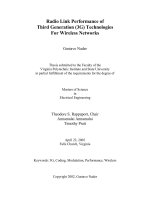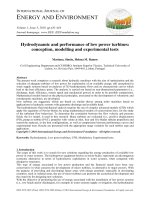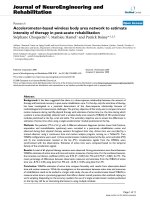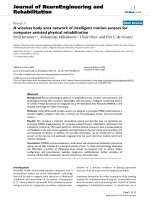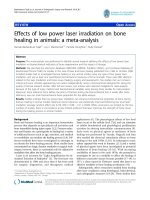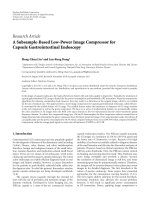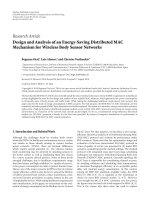Design implementation of low power MAC protocol for wireless body area network
Bạn đang xem bản rút gọn của tài liệu. Xem và tải ngay bản đầy đủ của tài liệu tại đây (15.67 MB, 108 trang )
DESIGN AND IMPLEMENTATION OF LOW
POWER MAC PROTOCOL FOR WIRELESS BODY
AREA NETWORK
PAN RUI
(Bachelor of Engineering (Hons.),
National University of Singapore, Singapore)
A THESIS SUBMITTED FOR
THE DEGREE OF DOCTOR OF PHILOSOPHY
DEPARTMENT OF ELECTRICAL AND COMPUTER
ENGINEERING
NATIONAL UNIVERSITY OF SINGAPORE
2014
This page intentionally left blank
Declaration
I hereby declare that this thesis is my original work and
it has been written by me in its entirety. I have duly
acknowledged all the sources of information which have
been used in the thesis.
This thesis has also not been submitted for any degree
in any university previously.
PAN RUI
13TH AUG 2014
iii
This page intentionally left blank
Design and Implementation of Low Power MAC Protocol for
Wireless Body Area Network
by
Pan Rui
Submitted to the Department of Electrical and Computer Engineering
on 13th Aug 2014, in partial fulfillment of the
requirements for the degree of
Doctor of Philosophy
Abstract
A wireless body area network (WBAN) is a network consists of wearable wireless
computing devices. Advances in low power integrated circuits make it possible to
mount miniaturized sensor nodes on the human body to form such a network for
collecting one’s physiological data, such as vital sign, movements etc.
In a WBAN system, a sensor node should not interfere users’ daily activities,
and should be battery-powered to work for days or even months for a single charge.
This requires the sensor nodes to be in small size and consume low power. In this
dissertation, the hardware implementation and the medium access control (MAC)
protocol design for WBAN systems are explored.
In the first part of this dissertation, a WBAN system with a real-time
scalable network controller IC for multi-patient wireless vital sign monitoring is
demonstrated. The controller chip incorporates a light-weight TDMA MAC protocol
assuming an ideal channel conditions between sensor nodes and a hub. The system
is scalable to accommodate multi-node and different applications such as ECG,
blood pressure, or temperature, while achieving sufficient quality-of-service (QoS)
for these applications. A low-complexity silent node association process, which does
not require special frame exchange, allows new nodes to join the network in real-time
without intervening in normal network operation. This makes the system suitable for
network environments such as that in a hospital ward, in which vital monitoring of
existing patients should not be interrupted by newly admitted patients. A proprietary
network controller IC is realized in 65nm CMOS technology, which consists of the
light-weight TDMA MAC layer and a 2.4 GHz OOK RF transceiver. Measured at
an effective throughput of 18 kbps, the proposed system achieves a packet delivery
rate (PDR) of > 99.9%. The proposed system serves as a baseline design such that
future systems can be built upon it.
Besides the effort in hardware design, the MAC protocol also plays an important
v
role. An efficient MAC protocol design can ensure the application QoS and improve
the energy efficiency of the sensor nodes.
The second part of this dissertation focuses on the MAC protocol design for a
WBAN system. When designing such a MAC protocol, a unique characteristic
that affects the application QoS is the varying on-body communication channel
conditions. It makes the transmission between a sensor node and a body-worn
coordinator vulnerable to poor channel conditions caused by body shadowing. One
possible solution to this is the use of relays where direct transmission to the hub is
not possible. The two-hop relay mechanism proposed in IEEE 802.15.6 standard
can be divided into three processes, namely channel assessment, relaying node
election and data relaying. However as these three processes are initiated at different
time intervals, simulations suggest that channel conditions actually vary between
processes, which leads to data relaying failure. In order to reduce the possibility
of data relaying failure, a relay mechanism with predefined relaying nodes are
introduced and evaluated against the relay mechanism proposed in IEEE 802.15.6
standard. A predefined relaying node will be active during the data relaying process
even if it is not elected. Simulations show that the proposed relay mechanism is able
to achieve 50% reduction in data relaying failure rate, which in turn improves the
packet delivery rate. The proposed relay mechanism is evaluated in a superframe
structure. Simulation shows that with the presence of the predefined relaying node,
the network lifetime is extended by 8%. To further improve the packet delivery rate,
direct transmission in the relaying process is supported, and a dynamic scheduling
algorithm is proposed to optimize slot allocation in the superframe for all nodes. The
proposed relay protocol achieves 21% improvements in network lifetime and 14%
improvements in PDR with decreasing transmission powers from -10 dBm to -15
dBm.
Acknowledgments
I would like to sincerely express my gratitude to my supervisors, Prof. Xu
Yong Ping and Dr. Jaya Shankar Pathmasuntharam, for their patience, guidance,
encouragement, continuous supporting and understanding.
I am also thankful to my labmates Chua Dingjuan, Zhao Wenfeng, Ng Kian
Ann, Li Yongfu, Zhao Jianming, and Wu Tong, for all the technical discussions
and encouragements throughout the years. Special thanks to Chua Dingjuan and
Zhao Wenfeng, for precious ideas on papers and testings, especially Chua Dingjuan,
without whom this dissertation would not have been possible.
I would also like to thank MediaTek Singapore for the sponsorship of the chip
fabrication.
Last but not the least, I would like to thank my family, especially my wife, for
sharing the ups and downs throughout the years.
vii
This page intentionally left blank
Contents
Abstract v
Acknowledgements vii
Contents ix
List of Figures xiii
List of Tables xv
1 Introduction 1
1.1 Background of Wireless Body Area Network . . . . . . . . . . . . . 1
1.2 Problem Statement . . . . . . . . . . . . . . . . . . . . . . . . . . . 4
1.3 Research Objectives and Contributions . . . . . . . . . . . . . . . . . 6
1.3.1 Research Objectives . . . . . . . . . . . . . . . . . . . . . . . 6
1.3.2 Research Contributions . . . . . . . . . . . . . . . . . . . . . . 7
1.4 Organization of the Dissertation . . . . . . . . . . . . . . . . . . . . 8
2 Literature Review 11
2.1 Background . . . . . . . . . . . . . . . . . . . . . . . . . . . . . . . 11
2.1.1 Quality of Service . . . . . . . . . . . . . . . . . . . . . . . . 11
2.1.2 The Varying On-Body Channel Conditions . . . . . . . . . . . 14
2.2 Review of Existing Works on Implementation of WBAN Systems . . 17
2.3 Review of Existing Works on Relay Protocols to Mitigate the Effects
of the Varying On-Body Channel Conditions . . . . . . . . . . . . . . 18
2.4 Conclusion . . . . . . . . . . . . . . . . . . . . . . . . . . . . . . . 21
3 A Real-Time Scalable Network Controller IC for Multi-Patient
Wireless Vital Sign Monitoring 23
3.1 Real-Time Scalable Light-Weight TDMA MAC Protocol . . . . . . . 24
ix
3.1.1 MAC Frames . . . . . . . . . . . . . . . . . . . . . . . . . . . 25
3.1.1.1 MAC Header . . . . . . . . . . . . . . . . . . . . . . . . 26
3.1.1.2 MAC Payload . . . . . . . . . . . . . . . . . . . . . . . . 27
3.1.1.3 Cyclic Redundancy Check . . . . . . . . . . . . . . . . . 28
3.1.2 MAC Functions . . . . . . . . . . . . . . . . . . . . . . . . . . 30
3.1.2.1 Silent node association . . . . . . . . . . . . . . . . . . . 30
3.1.2.2 Monitoring process . . . . . . . . . . . . . . . . . . . . . 31
3.1.2.3 Time Synchronization . . . . . . . . . . . . . . . . . . . . 33
3.2 System Design & Implementation . . . . . . . . . . . . . . . . . . . 33
3.2.1 Network Controller IC . . . . . . . . . . . . . . . . . . . . . . 38
3.3 System Measurement . . . . . . . . . . . . . . . . . . . . . . . . . . 40
3.3.1 Measurement Setup . . . . . . . . . . . . . . . . . . . . . . . . 40
3.3.2 Measurement & QoS Analysis . . . . . . . . . . . . . . . . . . 41
3.4 Conclusion . . . . . . . . . . . . . . . . . . . . . . . . . . . . . . . 45
4 OR-BAN: An Opportunistic Relay Protocol with Dynamic Scheduling
in Wireless Body Area Network 47
4.1 Review of IEEE 802.15.6 Relay Mechanism . . . . . . . . . . . . . . 48
4.1.1 Simulation Setup . . . . . . . . . . . . . . . . . . . . . . . . . 50
4.1.2 Simulation Result & Discussion . . . . . . . . . . . . . . . . . 54
4.2 OR-BAN: An Opportunistic Relay Protocol with Dynamic Scheduling
in Wireless Body Area Network . . . . . . . . . . . . . . . . . . . . 58
4.2.1 MAC Frames . . . . . . . . . . . . . . . . . . . . . . . . . . . 59
4.2.1.1 MAC Header . . . . . . . . . . . . . . . . . . . . . . . . 62
4.2.1.2 MAC Payload . . . . . . . . . . . . . . . . . . . . . . . . 63
4.2.1.3 Cyclic Redundancy Check . . . . . . . . . . . . . . . . . 64
4.2.2 MAC Functions . . . . . . . . . . . . . . . . . . . . . . . . . . 64
4.2.3 Dynamic Scheduling in the Normal Period . . . . . . . . . . . 67
4.2.4 Evaluation of Proposed Relay Protocol . . . . . . . . . . . . . 67
4.3 Conclusion . . . . . . . . . . . . . . . . . . . . . . . . . . . . . . . 79
5 Conclusion and Future Works 81
5.1 Conclusion . . . . . . . . . . . . . . . . . . . . . . . . . . . . . . . 81
5.2 Future Works . . . . . . . . . . . . . . . . . . . . . . . . . . . . . . 83
List of Publications 85
Bibliography 87
This page intentionally left blank
List of Figures
Figure 1.1 A typical WBAN system . . . . . . . . . . . . . . . . . . . 2
Figure 1.2 Example of body shadowing . . . . . . . . . . . . . . . . . 5
Figure 2.1 Frame format of IEEE 802.15.6 standard [1] . . . . . . . . . 13
Figure 2.2 Received signal strength in time [24] . . . . . . . . . . . . . 16
Figure 3.1 Frame Design . . . . . . . . . . . . . . . . . . . . . . . . . 26
Figure 3.2 State Machine Design . . . . . . . . . . . . . . . . . . . . . 29
Figure 3.3 Monitoring Process with ACK-Retry Mechanism . . . . . . 32
Figure 3.4 Block diagram of the proposed base station and wireless node 34
Figure 3.5 Block diagram of proposed TX physical layer . . . . . . . . 34
Figure 3.6 Block diagram of proposed RX physical layer . . . . . . . . 34
Figure 3.7 Realization of CRC-16-CCITT Serial Encoder/Decoder with
LFSR . . . . . . . . . . . . . . . . . . . . . . . . . . . . . 36
Figure 3.8 Example of (11,7) Hamming algorithm for error detection [38] 37
Figure 3.9 Encoding and decoding process of Manchester coding . . . . 38
Figure 3.10 Die Photo of the Network Controller IC . . . . . . . . . . . 39
Figure 3.11 Block diagram of proposed transceiver design . . . . . . . . 39
Figure 3.12 Block diagram of proposed MAC layer . . . . . . . . . . . . 40
Figure 3.13 Oscilloscope Screenshots . . . . . . . . . . . . . . . . . . . 42
Figure 3.14 Silent Node Association Process . . . . . . . . . . . . . . . 42
Figure 3.15 PDR vs Payload Size per Packet . . . . . . . . . . . . . . . 44
Figure 4.1 IEEE 802.15.6 Beacon Mode with Superframe Boundaries [1] 49
Figure 4.2 IEEE 802.15.6 Two-hop Extended Star Network Topology [1] 49
Figure 4.3 On-body Sensor Placement[24] . . . . . . . . . . . . . . . . 51
Figure 4.4 Simplified Superframe Structure . . . . . . . . . . . . . . . 52
Figure 4.5 Data Relaying Failure Rate and Packet Delivery Rate for
Node 1 and Node 2 . . . . . . . . . . . . . . . . . . . . . . 55
xiii
Figure 4.6 Data Relaying Failure Rate and Packet Delivery Rate for
Node 3 and Node 4 . . . . . . . . . . . . . . . . . . . . . . 56
Figure 4.7 Data Relaying Failure Rate and Packet Delivery Rate for
Node 5 . . . . . . . . . . . . . . . . . . . . . . . . . . . . . 57
Figure 4.8 Frames Design . . . . . . . . . . . . . . . . . . . . . . . . 59
Figure 4.9 Example of frame exchanges in Normal Period . . . . . . . 65
Figure 4.10 Examples of frame exchanges in Relay Period . . . . . . . . 66
Figure 4.11 Comparison of data relaying failure rate between disabling
and enabling dynamic scheduling at transmission powers of
-10 dBm and -12 dBm . . . . . . . . . . . . . . . . . . . . 71
Figure 4.12 Comparison of data relaying failure rate between disabling
and enabling dynamic scheduling at transmission powers of
-15 dBm and -20 dBm . . . . . . . . . . . . . . . . . . . . 72
Figure 4.13 Comparison of packet delivery rate between disabling and
enabling dynamic scheduling at transmission powers of -10
dBm and -12 dBm . . . . . . . . . . . . . . . . . . . . . . . 73
Figure 4.14 Comparison of packet delivery rate between disabling and
enabling dynamic scheduling at transmission powers of -15
dBm and -20 dBm . . . . . . . . . . . . . . . . . . . . . . . 74
Figure 4.15 Comparison of Packet Latency with Different Relay Schemes 76
List of Tables
Table 1.1 Examples of WBAN applications [11] . . . . . . . . . . . . 4
Table 2.1 List of Communication Scenarios [21] . . . . . . . . . . . . 14
Table 3.1 Technical Requirements for Vital Sign Monitoring
Applications [11] . . . . . . . . . . . . . . . . . . . . . . . 24
Table 3.2 Frame Type & BSID . . . . . . . . . . . . . . . . . . . . . 26
Table 3.3 Performance Summary & Comparison with Existing Works . 45
Table 4.1 Simulation Settings . . . . . . . . . . . . . . . . . . . . . . 53
Table 4.2 Frame Type . . . . . . . . . . . . . . . . . . . . . . . . . . 62
Table 4.3 Energy consumption with/without the predefined relaying
node* . . . . . . . . . . . . . . . . . . . . . . . . . . . . . 68
Table 4.4 Initial schedules upon system start-up . . . . . . . . . . . . 69
Table 4.5 Energy consumption at different transmission powers with
initial schedule 3 . . . . . . . . . . . . . . . . . . . . . . . 78
xv
This page intentionally left blank
Chapter 1
Introduction
1.1 Background of Wireless Body Area Network
A wireless body area network (WBAN) is a network consists of wearable wireless
computing devices. It was first introduced around 1995. Since then, with the rapid
growth in low-power integrated circuits, it drew huge attentions in healthcare and
biomedical applications. In 2007, IEEE 802.15 Task Group 6 was established for
the standardization of WBAN. It is aimed to address the need of a suitable standard
for communications in the vicinity of, or inside, a human body (but not limited to
humans) by considering the power consumption and quality of service (QoS) [1].
The standard defines a medium access control (MAC) protocol and requirements for
physical layers working in different frequency bands for both radio frequency (RF)
communication and human body communication (HBC) that makes the human body
as the communication medium. In 2012, the standard was released to public.
In a wireless body area network (WBAN), several wireless nodes are mounted on
human body for data collection or actuation. The collected data is then stored in a
coordinator placed on/off the human body. Fig. 1.1 depicts an example of a WBAN
system, in which the on-body hub, which can be a mobile phone or a smart watch,
1
CHAPTER 1. Introduction
Figure 1.1: A typical WBAN system
gathers data, such as ECG, EEG, motion, blood pressure, and etc from different
wireless nodes. If the received data shows critical situations such as abnormal heart
conditions, the hub will contact a remote base station, which is connected to a
hospital or a healthcare provider, such that further actions can be taken. Otherwise,
the hub will just update/alert the user about his/her current conditions visually on the
screen of the hub or through other measures, such as vibration and sounds.
In a WBAN system, a sensor node should not interfere with users’ daily activities,
and should be battery-powered to work for days or even months for a single charge.
This requires the sensor nodes to be in small size and consume low power.
Different sensor node designs have been proposed by researchers. They can be
categorized into designs built with commercial-off-the-shelf (COTS) components
and designs built with proprietary application-specific-integrated-circuits (ASICs).
The COTS based designs offer a flexible platform, in which different sensor nodes
can be accommodated, while ASIC based designs try to provide single chip solutions
for selected applications. In terms of sensor nodes’ footprint, these two types
of designs can both offer miniaturized nodes, but the latter provides more energy
2
CHAPTER 1. Introduction
efficient design, which is a very important aspect to consider when designing a
WBAN system.
Besides the efforts in hardware design, MAC protocol also plays a very important
role as it defines how the wireless medium is being shared by all nodes. An efficient
MAC protocol design can ensure the application QoS and improve the energy
efficiency of the sensor nodes as the energy wastage caused by idle listening and
collisions can be minimized.
Research shows that most WBAN systems adopt the MAC layer of IEEE 802.15.4
standard [2] since it is a mature technology and commercially available at low cost.
However it has been shown that it is not suitable for WBAN systems due to the
limitations posed by its superframe design [3].
In commercial consumer electronics, Bluetooth low energy (BLE) [4] is the most
widely adopted standard as it can be found in [5–8]. Compared to IEEE 802.15.4
standard, it achieves lower energy consumption, simpler protocol design and shorter
data packets with fixed length. BLE combines the frequency division multiple access
(FDMA) and time division multiple access (TDMA), which makes it more robust to
interference and collisions. And theoretically it can support up to 2
32
nodes in a
network[9] and a maximum application throughput of 236.7 kbps [10]. However,
measurement shows that it can support an effective application throughput of 58.48
kbps [10], which makes it unsuitable for real time monitoring applications such as
multi-lead ECG monitoring.
As for the IEEE 802.15.6 standard, by the time this dissertation is written, the
proposed MAC protocol has not been used in any commercial products. This
is probably because in order to accommodate a wide variety of applications,
great flexibility is provided at the MAC layer by incorporating different channel
access schemes, such as carrier sensing multiple access with collision avoidance
(CSMA/CA), ALOHA and time division multiple access (TDMA). Thus it takes
3
CHAPTER 1. Introduction
time for designers to decide the best options to be implemented such that an optimum
solution can be provided. Another possible reason is that the existing available
commercial systems support low throughput applications with limited number of
nodes such that current technologies are still enough to address the needs.
1.2 Problem Statement
A WBAN system is expected to support a wide variety of applications in
healthcare, biomedical, lifestyle, entertainment, sports, military and etc. Table 1.1
summarizes some of these applications.
Table 1.1: Examples of WBAN applications [11]
Application Examples
Healthcare Vital sign monitoring, sleep analysis, gait analysis, fall detection
Biomedical Prostheses, implanted drug delivery, capsule endoscope
Life Style Posture detection, ambient intelligence
Entertainment Gaming, gesture detection
Sports Activity monitoring, pedometer, fitness training
Military Blast dosimeter, solders’ vital sign monitoring
As can be seen from the table, most of the applications require the collection
of users’ physiological data, such as vital sign and movements. Therefore, in this
dissertation, monitoring applications with similar data set will be considered.
To design a MAC protocol for a WBAN system, it is important that application
QoS requirements, in terms of latency, throughput and reliability, can be satisfied.
This is especially crucial when designing a system for biomedical or healthcare
applications, in which excessive delay, and signal distortions caused by unreliable
communications would be harmful to the end user.
Depends on application scenarios, monitoring applications can be categorized
into real time monitoring and long term data logging. In real time monitoring,
4
CHAPTER 1. Introduction
sampled data needs to be sent to the hub in a timely and reliable way. As for data
logging, sampled data is sent to the hub only when it is required to, thus energy
efficiency is greatly improved by reducing the number of transmissions in this case.
Therefore a WBAN system should be able to accommodate different application
requirements under different application scenarios.
(a) Sensor placement
(b) Top view of the human body with sensors
while standing still
(c) Top view of the human body with sensors
while in motion
Figure 1.2: Example of body shadowing
In WBAN, a unique characteristic that affects the application QoS is that the
channel conditions between different nodes on a human body are changing all the
time. It is caused by the human body shadowing [12] as humans are always in
motion. Fig. 1.2 depicts an example of body shadowing, in which Fig. 1.2a
illustrates the transmitters and receiver placement with two transmitters, Tx1 and
Tx2 placed on user’s left and right wrists respectively, while one receiver, Rx, is
placed on the left side of the hip. Fig. 1.2b and 1.2c show the top view of the human
torso in the given example. As shown, with the user standing still, the line of sight
5
CHAPTER 1. Introduction
(LOS) communication between Tx2 and Rx is blocked by the human body, which
causes degradation in received signal strength, while in motion such as walking,
with the arms swinging forward and backward, Tx2 will experience different channel
conditions to Rx in different time intervals. For Tx1, due to its advantageous location
to Rx, it has a better channel conditions most of the time compared to that of Tx2.
Various experiments on characterization of the on-body channel conditions have
been conducted by researchers [13–16]. It is shown that the path loss of the RF
signal can go up to 80 dB [17]. Thus with this unique characteristic, reliable
communications between sensor nodes and the hub is not guaranteed in WBAN,
which makes the system unable to satisfy the application QoS requirements and
consume more energy on data retransmissions. To mitigate the body shadowing
effect, different techniques have been proposed, such as adaptive control of
transmission power [18], body shadowing avoidance by delaying transmissions [19],
and relay mechanism in which transmission is performed with the help of other nodes
[20]. The relay mechanism is a promising solution to this issue in terms of latency
and energy consumption compared to the other two techniques. Therefore, the body
shadowing effect mitigation through relays will be considered in this dissertation.
1.3 Research Objectives and Contributions
1.3.1 Research Objectives
The objective of this project is to develop a low power MAC protocol for a WBAN
system and implement it in ASIC. Thus the primary goal of this project includes the
following:
1. To develop a WBAN system architecture for monitoring applications, which
may include a physical layer for RF communications, a MAC layer, and an
6
CHAPTER 1. Introduction
application layer. The system should be able to fulfill different application
QoS requirements.
2. The MAC layer should be able to address the issue of the varying on-body
channel condition and improve the system energy efficiency in terms of
network lifetime. Moreover, the MAC layer should be of low complexity for
easy implementation, and consumes low power.
3. The design of the physical and application layers are not the concerns of this
dissertation.
1.3.2 Research Contributions
As discussed in Section 1.2, the varying on-body channel conditions has great
impact on application QoS and energy efficiency. Therefore, this dissertation will
focus on the MAC protocol design, which addresses the issue by adopting relay
mechanisms. Besides, the hardware implementation of a WBAN system will also be
discussed and described. This divides the dissertation into two parts.
The first part of the dissertation focuses on the hardware implementation of the
MAC protocol as part of a network controller IC. To reduce the implementation
complexity, a light-weight TDMA MAC protocol assuming an ideal channel
condition is proposed and implemented. The proposed protocol has a complexity
of about 4 k-gates and a size measured about 100 µm by 100 µm in 65nm CMOS
technology. And it operates at a clock frequency of 5 MHz with a simulated average
power consumption of 20 µW. With the proposed network controller IC, a WBAN
system for vital sign monitoring is constructed. To enhance the communication
reliability, a digital baseband, which consists of the (21,16) Hamming algorithm
for error correction and the CRC-16-CCITT for error detection, is implemented in
an FPGA board. The system described in this part serves as a baseline design such
that future systems can be built upon it.
7
CHAPTER 1. Introduction
In the second part of the dissertation, an opportunistic relay protocol with
pre-defined relaying nodes to mitigate the body shadowing effect for monitoring
applications is proposed and evaluated. With the proposed relay mechanism, the data
relaying failure rate in IEEE 802.15.6 standard is reduced by about 50%. And with
the presence of the pre-defined relaying node, the network lifetime of the proposed
protocol is extended by 8%. Besides, with a dynamic scheduling algorithm and
decreasing transmission powers from -10 dBm to -15 dBm, the proposed protocol
achieves 21% improvements in network lifetime and 14% improvements in packet
delivery rate.
1.4 Organization of the Dissertation
The rest of this dissertation is organized as follows.
Chapter 2 presents the literature review of existing works on WBAN system
designs. The review will be based on hardware implementation of wireless
sensor nodes for a WBAN system and the varying on-body channel conditions, as
mentioned in Section 1.3.1.
Chapter 3 describes a real-time scalable network controller IC for multi-patient
wireless vital sign monitoring. The controller chip incorporates a light-weight
TDMA MAC protocol. In a hospital ward, where patients check in/out the ward
frequently, with the proposed MAC protocol, it enables the real-time node insertion
without intervening in normal monitoring of existing patients. The design also
addresses the QoS requirements of vital sign monitoring, such as ECG, body
temperature, respiratory, and blood pressure.
Chapter 4 discusses the impact of the varying on-body channel conditions on
the performance of a WBAN system. To mitigate the body shadowing effect, relay
mechanisms are considered. By reviewing the relay mechanism proposed in IEEE
8
CHAPTER 1. Introduction
802.15.6 standard, its limitations and improvements are discussed and evaluated to
arrive at an opportunistic relay protocol in WBAN. The effect of dynamic scheduling
on relay discovery is also discussed with the proposed relay protocol.
Conclusions and future work will be presented in Chapter 5.
9
